Pheidole havilandi
| Pheidole havilandi | |
|---|---|

| |
| Scientific classification | |
| Kingdom: | Animalia |
| Phylum: | Arthropoda |
| Class: | Insecta |
| Order: | Hymenoptera |
| Family: | Formicidae |
| Subfamily: | Myrmicinae |
| Tribe: | Attini |
| Genus: | Pheidole |
| Species: | P. havilandi |
| Binomial name | |
| Pheidole havilandi Forel, 1911 | |
| Synonyms | |
| |
This species inhabits well-developed forests from lowlands to hill areas, probably not exceeding 1000 malt. (Eguchi 2001)
Identification
Eguchi (2001) - This relatively large-sized species is characterised among Indo-Chinese and Indo-Malayan congeners by a combination of the following characteristics: vertex and occipital lobe smooth and shining in the major; eye relatively small in both the subcastes; hypostoma of the major lacking median processes; posterior declivity of promesonotal dome lacking a prominence in both the subcastes; petiole almost as long as postpetiole in both the subcastes.
Keys including this Species
- Key to Pheidole majors and minors of Borneo
- Key to Pheidole majors of Borneo
- Key to Pheidole minors of Borneo
Distribution
Southern Malay Peninsula, Borneo, Sumatra and Mentawai Is. (Eguchi 2001)
Latitudinal Distribution Pattern
Latitudinal Range: 10.927° to 3.258333333°.
| North Temperate |
North Subtropical |
Tropical | South Subtropical |
South Temperate |
- Source: AntMaps
Distribution based on Regional Taxon Lists
Indo-Australian Region: Borneo (type locality), Indonesia, Malaysia.
Distribution based on AntMaps
Distribution based on AntWeb specimens
Check data from AntWeb
Countries Occupied
| Number of countries occupied by this species based on AntWiki Regional Taxon Lists. In general, fewer countries occupied indicates a narrower range, while more countries indicates a more widespread species. |

|
Estimated Abundance
| Relative abundance based on number of AntMaps records per species (this species within the purple bar). Fewer records (to the left) indicates a less abundant/encountered species while more records (to the right) indicates more abundant/encountered species. |

|
Biology
Eguchi (2001) - Together with many workers of this species (Eg98-BOR-849), many adults, nymphs and egg masses of Neuroctenus sp. (Heteroptera, Aradidae, Mezirinae; determined by Dr. Yoshinori Shono, 1998) were collected from spaces under barks of buttress roots of a tree stub and shelters which were made of soil and wood particles on the roots. The bugs are very probably a myrmecophile of P. havilandi, and antagonistic behavior of the ants to the bugs was not observed even when I strongly disturbed the colony. Usinger & Matsuda (1959), and Kormilev (1971) stated that many aradids are mycophagous, and feed on fungi under the bark of decaying trees or in the litter. The bugs possibly have a similar diet judging from the nesting habit of P. havilandi. Thus in this case it is not likely for the trophobiotic interaction through excreting drops of honeydew to occur between the bugs and ants. There is a possibility that the ants maintain the bugs as prey during severe food shortage as seen in the relationship between Myrmecina sp. and a myrmecophilous oribatid mite (Ito, 1994).
Castes
Worker
Minor
Images from AntWeb
   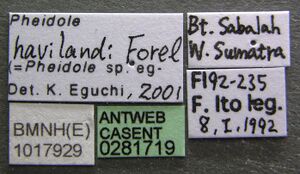
| |
| Worker. Specimen code casent0281719. Photographer Estella Ortega, uploaded by California Academy of Sciences. | Owned by NHMUK, London, UK. |
  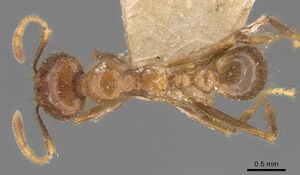 
| |
| Syntype of Pheidole havilandi. Worker. Specimen code casent0907884. Photographer Will Ericson, uploaded by California Academy of Sciences. | Owned by MHNG, Geneva, Switzerland. |
   
| |
| Paralectotype of Pheidole havilandi sapuana. Worker. Specimen code casent0907886. Photographer Will Ericson, uploaded by California Academy of Sciences. | Owned by MHNG, Geneva, Switzerland. |
   
| |
| Paralectotype of Pheidole havilandi selangorensis. Worker. Specimen code casent0907888. Photographer Will Ericson, uploaded by California Academy of Sciences. | Owned by MHNG, Geneva, Switzerland. |
Major
Images from AntWeb
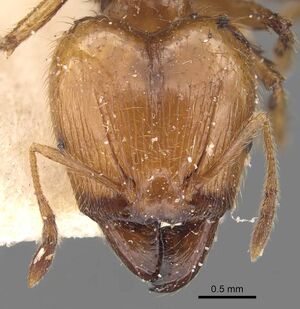 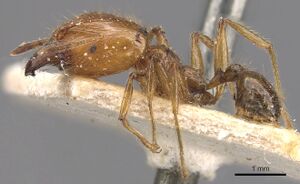  
| |
| Lectotype of Pheidole havilandi sapuana. Worker (major/soldier). Specimen code casent0907885. Photographer Will Ericson, uploaded by California Academy of Sciences. | Owned by MHNG, Geneva, Switzerland. |
   
| |
| Syntype of Pheidole havilandi. Worker (major/soldier). Specimen code casent0907883. Photographer Will Ericson, uploaded by California Academy of Sciences. | Owned by MHNG, Geneva, Switzerland. |
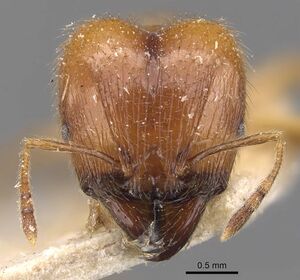 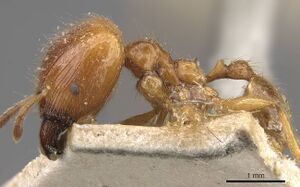  
| |
| Lectotype of Pheidole havilandi selangorensis. Worker (major/soldier). Specimen code casent0907887. Photographer Will Ericson, uploaded by California Academy of Sciences. | Owned by MHNG, Geneva, Switzerland. |
Nomenclature
The following information is derived from Barry Bolton's Online Catalogue of the Ants of the World.
- havilandi. Pheidole havilandi Forel, 1911a: 38 (s.w.q.m.) BORNEO. Senior synonym of sapuana, selangorensis: Eguchi, 2001a: 11. See also: Eguchi, 2001b: 59.
- sapuana. Pheidole havilandi var. sapuana Forel, 1911d: 373 (s.w.) INDONESIA (Sumatra). Junior synonym of havilandi: Eguchi, 2001a: 11.
- selangorensis. Pheidole havilandi var. selangorensis Forel, 1913k: 31 (s.w.q.m.) WEST MALAYSIA. Junior synonym of havilandi: Eguchi, 2001a: 11.
Unless otherwise noted the text for the remainder of this section is reported from the publication that includes the original description.
Description
Worker
Eguchi (2001) - Major (n=6): TL 3.5-4.7 mm, HL 1.44-1.97 mm, HW 1.45-1.93 mm, SL 0.83-0.91 mm, FL 1.20-1.50 mm, CI 97-101, SI 47-59, FI 78-84. Head broadest around 2/3 distance of head (as measured from the mid-point of a transverse line spanning the anteriormost and posteriormost projecting points, respectively; posterior margin of head gently concave medially (Fig. 19A); head in profile distinctly convex on upper frons, and without any impression on the posterior declivity from the top. Hypostoma without median processes. Clypeus without a median longitudinal carina, with anterior margin emarginate medially. Eye situated at about 2/5 distance of head; distance between mandibular insertion and anterior margin of eye 2.3-2.4 times as long as maximal diameter of eye (Fig. 19B). Frontal carina inconspicuous, extending backward to 3/5-2/3 distance of head. Antennal scrobe present only around antennal insertion. Antenna with 3-segmented club; scape extending backward to about 3/5 distance of head; terminal segment 1.0-1.1 times as long as preceding two segments together. Masticatory margin of mandible with apical and preapicai teeth, lacking a distinct denticle in front of basal angle. Promesonotal dome without a distinct prominence on its posterior declivity (Fig. 19C). Mesopleuron without a distinct transverse impression. Propodeal spine horn-like, ca. 1.5 times as long as diameter of propodeal spiracle. Petiole cuneiform, 1.0-1.1 times as long as postpetiole (excluding helcium); petiolar node in posterior view slightly emarginate at apex. Postpetiole in dorsal view subpentagonal, 2.2-2.3 times as broad as petiolar node.
Frons and gena longitudinally rugose; vertex and occipital lobe smooth and shining; alitrunk largely smooth and shining, or upper part of mesopleuron and anterolateral part of propodeum weakly punctured; lateral face of petiole weakly punctured; dorsum of petiole, and postpetiole largely smooth and shining; gaster smooth and shining. Outer face of mandible sparsely covered with long appressed to decumbent hairs, which are 0.09-0.20 mm in length and almost as long as distance between piligerous punctures. Head yellowish-brown to reddish-brown, with darker mandibles and with lighter occipital lobes; alitrunk and gaster deep yellowish-brown to brown, a little darker than head; legs a little lighter than alitrunk.
Minor Measurements and indices (n=7): TL 2.5-2.9 mm, HL 0.70-0.86 mm, HW 0.63-0.82 mm, SL 0.79-0.97 mm, AL 0.98-1.22 mm, FL 0.97-1.14 mm, CI 90-97, SI 116-125, FI 139-143. Head in full-face view with almost straight posterior margin (Fig. 19D); occipital carina weak but complete. Clypeus without a median longitudinal carina, with anterior margin in full-face view truncate medially. Eyes situated just behind midlength of head; distance between mandibular insertion and anterior margin of eye 1.5-1.6 times as long as maximal diameter of eye. Frontal carina and antennal scrobe present only around antennal insertion. Antenna with 3-segmented club; scape extending beyond posterior border of head by more than its 1/3 length; terminal segment 0.9-1.0 times as long as preceding two segments together. Promesonotal dome without a prominence on its posterior declivity (Fig. 19E). Mesopleuron sometimes with an inconspicuous transverse impression. Propodeal spine elongate-triangular, 1.5-2 times as long as diameter of propodeal spiracle. Petiole cuneiform, 1.0-1.1 times as long as postpetiole (excluding he1cium); petiolar node very low, in posterior view not emarginate at apex. Postpetiole in dorsal view subpentagonal, 2.0-2.3 times as broad as petiolar node.
Head including clypeus and promesonotum smooth and shining; mesopleuron and a part of lateral face of propodeum weakly punctured; remainder of propodeum smooth and shining; lateral face of petiole weakly punctured; dorsum of petiole, and postpetiole and gaster smooth and shining. Body light yellowish-brown to yellowish-brown; flagella and legs a little lighter than alitrunk.
Type Material
Eguchi (2001) - Major, minor, queen and male (Musee d'Histoire Naturelle Genève). Type locality: Sarawak, Borneo. Nine syntypes (2 majors, 3 minors, 1 queen and 3 males) were examined.
References
- Eguchi, K. 2001a. A revision of the Bornean species of the ant genus Pheidole (Insecta: Hymenoptera: Formicidae: Myrmicinae). Tropics Monograph Series. 2:1-154.
- Eguchi, K. 2001b. A taxonomic study on Asian Pheidole (Hymenoptera, Formicidae): new synonymy, rank changes, lectotype designations and redescriptions. Insecta Koreana. 18:1-35. (page 11, Senior synonym of sapuana and selangorensis)
- Eguchi, K. 2003. A Study on the Male Genitalia of Some Asian Species of Pheidole (Hymenoptera, Formicidae, Myrmicinae). Sociobiology 41(2): 317-355 (page 323, figs. 7A, B male genitalia described)
- Forel, A. 1911a. Fourmis de Bornéo, Singapore, Ceylan, etc. récoltées par MM. Haviland, Green, Winkler, Will, Hose, Roepke et Waldo. Rev. Suisse Zool. 19: 23-62 (page 38, soldier, worker, queen, male described)
References based on Global Ant Biodiversity Informatics
- Chapman, J. W., and Capco, S. R. 1951. Check list of the ants (Hymenoptera: Formicidae) of Asia. Monogr. Inst. Sci. Technol. Manila 1: 1-327
- Crawley W.C. 1924. Ants from Sumatra, with biological notes by Edward Jacobson. Annals and Magazine of Natural History (9)13: 380-409
- Eguchi K. 2001. A revision of the Bornean species of the ant genus Pheidole (Insecta: Hymenoptera: Formicidae: Myrmicinae). Tropics Monograph Series 2: 1-154.
- Eguchi K. 2001. A taxonomic study on Asian Pheidole (Hymenoptera, Formicidae): new synonymy, rank changes, lectotype designations and redescriptions. Insecta Koreana 18: 1-35.
- Eguchi K. 2003. A study on the male genitalia of some Asian species of Pheidole (Hymenoptera, Formicidae, Myrmicinae). Sociobiology 41: 317-355.
- Forel A. 1911. Fourmis de Bornéo, Singapore, Ceylan, etc. récoltées par MM. Haviland, Green, Winkler, Will, Hose, Roepke et Waldo. Rev. Suisse Zool. 19: 23-62.
- Forel A. 1911. Fourmis nouvelles ou intéressantes. Bull. Soc. Vaudoise Sci. Nat. 47: 331-400.
- Forel A. 1913k. Wissenschaftliche Ergebnisse einer Forschungsreise nach Ostindien ausgeführt im Auftrage der Kgl. Preuss. Akademie der Wissenschaften zu Berlin von H. v. Buttel-Reepen. II. Ameisen aus Sumatra, Java, Malacca und Ceylon. Gesammelt von Herrn Prof. Dr. v. Buttel-Reepen in den Jahren 1911-1912. Zoologische Jahrbücher. Abteilung für Systematik, Geographie und Biologie der Tiere 36:1-148.
- Kishimoto-Yamata K., F. Hyodo, M. Matsuoka, Y. Hashimoto, M. Kon, T. Ochi, S. Yamane, R. Ishii, and T. Itioka. 2012. Effects of remnant primary forests on ant and dung beetle species diversity in a secondary forest in Sarawak, Malaysia. Journal of Insect Conservation DOI 10.1007/s10841-012-9544-6
- Pfeiffer M., D. Mezger, and J. Dyckmans. 2013. Trophic ecology of tropical leaf litter ants (Hymenoptera: Formicidae) - a stable isotope study in four types of Bornean rain forest. Myrmecological News 19: 31-41.
- Pfeiffer M.; Mezger, D.; Hosoishi, S.; Bakhtiar, E. Y.; Kohout, R. J. 2011. The Formicidae of Borneo (Insecta: Hymenoptera): a preliminary species list. Asian Myrmecology 4:9-58
- Smith M. A., W. Hallwachs, D. H. Janzen. 2014. Diversity and phylogenetic community structure of ants along a Costa Rican elevational gradient. Ecography 37(8): 720-731.
- Wheeler W. M. 1919. The ants of Borneo. Bulletin of the Museum of Comparative Zoology 63:43-147.


